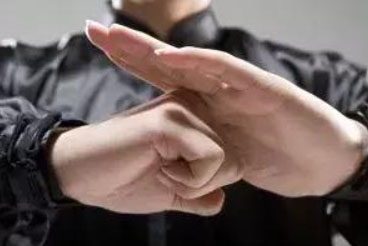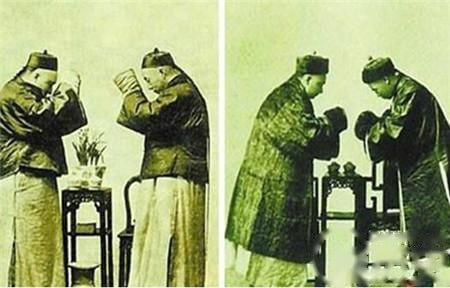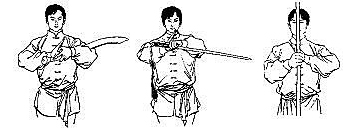Introduction:
The traditional salute of Chinese martial arts is formed by closing the right fist and covering it with the left hand open, and extending both arms slightly forward in front of the chest.
This greeting is called bàoquánlǐ 抱拳禮 ("fist covering greeting" or "fist covering ceremony"), although it is also often referred to as gǒngshǒulǐ 拱手禮 ("presentation of respects") or simply jiànlǐ 見禮 ("salute").

Bàoquánlǐ 抱拳禮.
This form of showing courtesy is an evolution of the Confucian civil greeting of ancient times (zuòyīlǐ作揖禮), formed with the fist slightly loose, wrapped by the other hand that covers it completely, and performed with a slight bow.
In the case of zuòyīlǐ, men cover their right fist with their left hand, and women do it the other way around (this distinction does not exist in the martial arts salute).


Zuòyīlǐ 作揖禮.
It is important to note that, in the current martial salute, it should always be the left hand that is placed on the right fist, thus considered an auspicious greeting (jí bài 吉拜), and not vice versa, which is considered an ominous greeting (xiōng bài 兇拜). This last greeting is only used to express condolences at funerals, and otherwise it is considered very disrespectful, and can be taken as an invitation to fight.
Meaning of the martial salutation:
There are multiple theories and stories about the meaning of this greeting, so let's point out below only the three that we consider most important and representative:
"Between the five lakes and the four seas, we are all brothers" (五湖四海皆兄弟 wǔhúsìhǎi jiē xiōngdì)
The five fingers of the right hand that close in a fist represent the five most important lakes in China. The four outstretched fingers of the left hand represent the four seas, that is, the oceans in the four cardinal directions. Together, the five lakes and four seas (wǔhúsìhǎi 五湖四海) is an expression representing the totality of the Earth.
Understood in this way, the greeting would represent brotherhood among all martial arts practitioners.
"Overthrow the Qīng and restore the Míng" (反清復明 fǎn Qīng fù Míng)
It has been speculated that the martial salute could represent the Chinese word Míng 明, formed by the radicals rì 日, sun, and yuè 月, moon, which would be represented by the right fist and the left hand, respectively.
In this way, the salute would have been used as a secret sign among the rebels fighting to overthrow the Qīng 清 dynasty, of Manchu origin, and restore the ancient Míng dynasty. Although this interpretation is certainly unrealistic and based on a legend, it is quite widespread and worth mentioning.
As an alternative note, it should also be noted that practitioners of Tàijíquán 太極拳 use this same simile of the sun and the moon to form the word míng 明, understood this time in its meaning of "bright" or "clear" and that in this case represents illumination.
"Putting self-control before the use of force"
This is undoubtedly the meaning with which we most identify. According to this interpretation, the fist represents the force and the palm represents control over that force.
This can also be represented by the phrase wénwǔ shuāngxiū 文武雙修, "to cultivate both the civil and the martial". In this case, civil would refer to virtues such as courtesy and respect. Any martial artist has a great responsibility for the use of his or her knowledge and should always put these values before fighting.
Therefore, when it is necessary to greet with only one hand (for example, when having the other one occupied), the palm is always used and not the fist, which would be considered offensive. Greeting only with the fist shows a lack of self-control, on the one hand, and respect for the other person, on the other, and is something shameful and should be avoided.
Thus, when weapons are carried in the hand during martial practice, they must be held in the non-dominant hand, usually the left, in a position that is not offensive, and greet with the open palm in the other hand. In this way you show morality and it is understood that you are not willing to use the weapon; in addition, the open right hand shows that no throwing weapon is concealed and there is nothing to hide.

Martial salute holding weapons.
